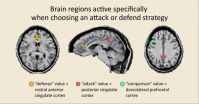(Press-News.org) Dispensing of prescription opioid pain relievers and prescription opioid overdoses both dropped substantially after abuse-deterrent extended-release oxycodone hydrochloride was introduced on the pharmaceutical market and the narcotic drug propoxyphene was withdrawn from the U.S. market in 2010, according to an article published online by JAMA Internal Medicine.
The abuse-deterrent OxyContin formulation is resistant to crushing and dissolving, actions that have been used to bypass the extended-release mechanism to get a quicker and more intense high. Propoxyphene (also known as Darvon) was approved in 1957 for the treatment of pain; reports of abuse were reported soon after and, by 1977, propoxyphene was the second leading agent in prescription drug-induced deaths. Propoxyphene was voluntarily withdrawn from the U.S. market in response to emerging data about cardiac toxic effects. Some speculated reducing the supply of prescription opioids would lead those individuals already addicted to substitute with alternative prescription opioids or heroin, according to the study background.
Marc R. Larochelle, M.D., M.P.H., of the Harvard Medical School and Boston University School of Medicine, and coauthors examined the association between these two supply-based interventions on opioid dispensing and overdose. The authors analyzed claims from a large national U.S. health insurer with data on 31.3 million insured members from 2003 through 2012.
Study results indicate total opioid dispensing decreased by 19 percent from the expected rate two years after the opioid pharmaceutical market changes and the estimated overdose rate dropped by 20 percent However, the authors found heroin overdose increased by 23 percent.
"Our results have significant implications for policymakers and health care professions grappling with the epidemic of opioid abuse and overdose. Changes imposed through regulatory mandates or voluntary company actions may be a viable approach to stemming prescription abuse. However, identifying interventions that reduce opioid supply without affecting access to individuals who benefit from opioid therapy remains a challenge. ... Finally, although restricted opioid supplies might decrease new-onset addiction in the future, it will not cure existing addiction. Regardless of the mediating mechanism, a transition from prescription opioid to heroin abuse has been well documented and further efforts are needed to improve identification and treatment of these individuals," the study concludes.
(JAMA Intern Med. Published online April 13, 2015. doi:10.1001/jamainternmed.2015.0914. Available pre-embargo to the media at http://media.jamanetwork.com.)
Editor's Note: An author made funding/support disclosures. Please see the article for additional information, including other authors, author contributions and affiliations, financial disclosures, funding and support, etc.
Commentary: Part of a Public Health Strategy to Reverse the Opioid Epidemic
In a related commentary, Hillary V. Kunins, M.D., M.P.H., M.S., of the New York City Department of Health and Mental Hygiene, writes: "Recasting the often-maligned 'doctor-shopper' instead as a patient with a substance use disorder reminds us that using public health strategies to promote judicious opioid prescribing, including via pharmaceutical market change to reduce overdose risk, needs to be accompanied by similar policy approaches to provide accessible and effective services for people who use drugs. Policy and public health interventions that both prevent opioid use disorders and overdose and provide access to treatment and other services to address consequences of opioid use disorder once it occurs are the two prongs of a comprehensive public health approach to address the opioid epidemic."
(JAMA Intern Med. Published online April 13, 2015. doi:10.1001/jamainternmed.2015.0939. Available pre-embargo to the media at http://media.jamanetwork.com.)
Editor's Note: Please see the article for additional information, including other authors, author contributions and affiliations, financial disclosures, funding and support, etc.
INFORMATION:
Media Advisory: To contact corresponding author Marc R. Larochelle, M.D., M.P.H., call Jenny Eriksen Leary at 617-638-6841 or email jenny.eriksen@bmc.org. To contact corresponding commentary author Hillary V. Kunins, M.D., M.P.H., M.S., call Christopher Miller at 347-396-4177 or email pressoffice@health.nyc.gov.
Children whose families and pediatricians were most faithful to an obesity intervention program that included computerized clinical decision support for physicians and health coaching for families experienced the greatest improvements in body mass index (BMI), according to an article published online by JAMA Pediatrics.
The prevalence of childhood obesity in the United States remains at historically high levels. Clinical approaches that are cost-effective and scalable for obesity reduction in children are a public health priority. However, interventions to improve BMI ...
(Boston) - Results of a new study led by Boston Medical Center (BMC) researchers, in collaboration with Harvard Medical School (HMS), indicate that the introduction of abuse-deterrent OxyContin, coupled with the removal of propoxyphene from the US prescription marketplace, may have played a role in decreasing opioid prescribing and overdoses. The findings, published in JAMA Internal Medicine, showed that these two changes led to a 19 percent drop in prescription opioid supply that was mirrored by a 20 percent drop in prescription opioid overdose between August 2010 and ...
Poor quality medicines are a real and urgent threat that could undermine decades of successful efforts to combat HIV/AIDS, malaria and tuberculosis, according to the editors of a collection of journal articles published today. Scientists report up to 41 percent of specimens failed to meet quality standards in global studies of about 17,000 drug samples. Among the collection is an article describing the discovery of falsified and substandard malaria drugs that caused an estimated 122,350 deaths in African children in 2013. Other studies identified poor quality antibiotics, ...
Researchers from the University of Birmingham have identified an important new way in which our immune systems are regulated, and hope that understanding it will help tackle the debilitating effects of type 1 diabetes, rheumatoid arthritis and other serious diseases.
The team discovered a novel pathway that regulates the movement of pathogenic immune cells from the blood into tissue during an inflammatory response.
A healthy, efficient immune system ordinarily works to damp down inflammation and carefully regulate the magnitude of the response to infection and disease. ...
A University of Texas at Austin scientist, working with an international research team, has developed the most precise sequence map yet of U.S. cotton and will soon create an even more detailed map for navigating the complex cotton genome. The finding may help lead to an inexpensive version of American cotton that rivals the quality of luxurious Egyptian cotton and helps develop crops that use less water and fewer pesticides for a cotton that is easier on the skin and easier on the land.
Z. Jeffrey Chen and his collaborators, Tianzhen Zhang and Wangzhen Guo at Nanjing ...
Using the latest genome sequencing techniques, a research team led by scientists from UC San Francisco (UCSF), Baylor College of Medicine, and Texas Children's Hospital has identified a new autoimmune syndrome characterized by a combination of severe lung disease and arthritis that currently has no therapy.
The hereditary disorder, which appears in early childhood, had never been diagnosed as a single syndrome. The new research revealed that it is caused by mutations in a single gene that disrupt how proteins are shuttled around within cells. Patients with the newly ...
We often make quick strategic decisions to attack an opponent or defend our position, yet how we make them is not well understood. Now, researchers at the RIKEN Brain Science Institute in Japan have pinpointed specific brain regions related to this process by examining neural activity in people playing shogi, a Japanese form of chess. Published in Nature Neuroscience, the study shows that two different regions within the cingulate cortex--one toward the front of the brain and the other toward the back--separately encode the values of defensive and offensive strategies.
Like ...
Large amounts of methane - whether as free gas or as solid gas hydrates - can be found in the sea floor along the ocean shores. When the hydrates dissolve or when the gas finds pathways in the sea floor to ascend, the methane can be released into the water and rise to the surface. Once emitted into the atmosphere, it acts as a very potent greenhouse gas twenty times stronger than carbon dioxide. Fortunately, marine bacteria exist that consume part of the methane before it reaches the water surface. Geomicrobiologists and oceanographers from Switzerland, Germany, Great Britain ...
New apps developed for children come online every day and many of them are marketed or labeled as "educational" - but how can we tell which of these thousands of apps will actually help children learn? A comprehensive new report published in Psychological Science in the Public Interest, a journal of the Association for Psychological Science, integrates research from scientific disciplines like psychological science, linguistics, and neuroscience to provide an evidence-based guide that parents, educators, and app designers alike can use to evaluate the quality of so-called ...
HANOVER, N.H. - Although the media often portray the Arctic as a new "Great Game" ripe for conflict, a group of international Arctic experts co-chaired by Dartmouth College released recommendations today aimed at preserving the polar north as an area for political and military cooperation, sustainable development and scientific research.
The report, which addresses the priorities of the Arctic Council, an intergovernmental forum of the eight nations that border the polar region, resulted from meetings at the Carnegie Endowment for International Peace in Washington, ...

